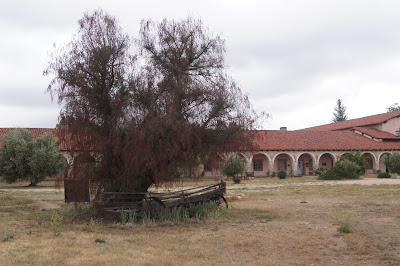Along the Mission Trail
As I tour the California missions, I come across many enchanting stories from the past. The story of a little boy named Jose Carabajal who built himself a violin to play in the orchestra at Mission San Antonio de Padua, is one of them.
Jose was born in 1798. His mother was a Native American and his father, a Spanish soldier stationed at the Carmel mission. The little boy loved music and clearly had a gift. He wanted desperately to play the violins in the mission's collection, but was not allowed to touch them. So what did he do? He copied their dimensions, scoured the woods and gathered dogwood, pine and bay laurel. He cut the wood into classical Baroque shapes, carved a fingerboard from dark red manzanita and put all the pieces together with pegs. It looked a little odd--shorter and wider than most violins, but what a sound! Deep. Angelic. Beautiful. The instrument became known as "The Carabajal." The boy became a musician.
When Padre Juan Bautista Sancho joined the mission at San Antonio de Padua around 1803, he brought with him a musical expertise. He had been the musical director at a convent in Mallorca. He composed music and played the harpsichord and organ. When he arrived, he learned the Salinan language, translated sacred texts and taught the local Indian community how to sing and read music. He painted huge notes on the walls and in massive hymn books. As the mission's population flourished and grew, he formed a choir and an orchestra from the eager talented congregation. Jose Carabajal was one of them.
This gigantic hand is painted on a museum wall at San Antonio. Father Sancho used his hands to conduct. Each joint on each finger represented a different note or chord. It must have been something to see: a padre's dancing hands leading a choir of voices. There were joyous simple songs, but there were also complex, classical pieces. Sancho continued to compose music; entire masses were sung.
The orchestra continued to thrive long after the mission was abandoned. Future generations continued to perform at local fiestas, masses and barn dances, well into the 20th century.
I lingered in the music room for a long time, listening to a recording of the Carabajal. The precious violin had been passed down through many generations. Jose's great-great-grandson donated it to the mission in 1973. It was fully restored in 2000 and played once again. The recording was hauntingly beautiful, but where was the violin? I saw a flute, a mandolin, some drums and a harp, but no violin.
Sadly, we learned it had been stolen in 2003. When John Warren, founder and leader of the New World Baroque Orchestra in Paso Robles went to the museum to retrieve it that summer, he was horrified to find someone had replaced this priceless instrument with a cheap modern version. Although the FBI was brought in to investigate, to this day it has not been found.








No comments:
Post a Comment